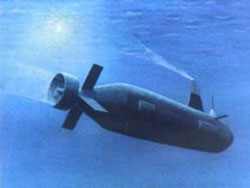Light-Speed Submarine

The theory of relativity is nearing its 100th birthday, but it still harbors some puzzles. In the July issue of Physical Review D a researcher lays out the first complete solution to a seeming paradox presented by relativity: A submarine moving at near-light speed should look a bit shorter and denser to observers on land, so it should sink. But the sailors on board should see the water getting denser, which would cause the sub to float. Relativity experts have known that the resolution lies in gravity’s special behavior in a fast-moving frame of reference, but no one had solved it in detail until now. The results could also add a further twist to a field Einstein did not foresee–the thermodynamics of black holes.
In this thought experiment, the submarine is the same density as water and doesn’t float or sink when at rest. But according to relativity, objects moving at high speed become shorter, so the sub’s total density is higher, according to land-based observers. On the other hand, relativity states that the sailors’ reference frame is equally valid. To them, the sub is stationary, and the ocean is rushing past at a higher density. The sailors might conclude that they will float, but they would be wrong. They not only see the water speeding by; they see a moving gravitational field as well. So the problem is more complicated than it may appear.
In 1989 James Supplee, now of Drew University and Stevens Institute of Technology in New Jersey, solved the problem using the limited form of the theory known as special relativity [1]. Although his solution used several approximations, it illustrates the ideas. Special relativity does not normally apply to problems that include gravity, so Supplee assumed that the ocean–but not the sub–accelerates upward at a rate that simulates gravitational effects. Inside an accelerating elevator far from Earth, for example, objects drop to the floor exactly as though gravity were pulling them.
Although from the sailors’ perspective buoyancy pushes them upward faster than the sea floor rises, the sub still hits the bottom, in Supplee’s solution. The reason is that the sea floor is not flat, but curves upwards, from their point-of-view, thanks to relativity’s strange effects on space and time. As the sea and curved seafloor rush horizontally past the sub, the floor becomes steeper and closer until finally it thwacks into the submarine.
George Matsas, of the State University of São Paulo in Brazil, now solves the problem mathematically using the full theory known as general relativity, which completely accounts for gravity. Paul Davies of Macquarie University in Sydney interprets the solution this way: Fast moving objects always carry extra energy, according to general relativity, but fast moving fields also gain energy. This more energetic field pulls the sub down more strongly than would a field at rest with respect to the sub.
Supplee is happy that the problem has now been solved in a more complete way. “Matsas has done the job,” he says. Matsas says his solution may also be relevant to black holes. The Second Law of Thermodynamics requires that black holes emit so-called Hawking radiation, which can exert a sort of “buoyant force” on nearby matter. A body that orbits a black hole rapidly should be “less buoyant,” according to Matsas’s work, and he’s now working out the implications of this effect.
–Kim Krieger
Kim Krieger is a freelance science writer in Norwalk, Connecticut.
References
- J. M. Supplee, Am. J. Phys. 57, 75 (1989)


